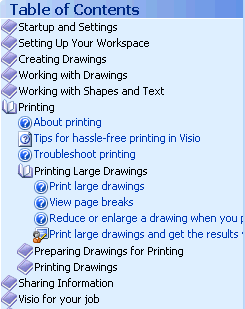Topic hierarchy
In DITA, the sequence and hierarchy of the topics to be published are defined in the ditamap through nested topicref elements.
A topic-based document architecture relies on a device to bind the topics together into a structured output publication. A Help system is a good example of a topic-based document architecture. The binding device in Help systems is called the Table of Contents, or TOC. The TOC is used by the author to choose the topics that will be included in the publication, and the order in which they will be presented in navigation. In most Help systems, the TOC is also presented to the reader as an expandable and collapsible tree of links, which the reader can use to navigate through the document.

Being topic-based, DITA also needs a TOC-type device to bind collections of DITA topics together, and the ditamap is used for that purpose. The ditamap not only specifies what topics are to be included in the output, but specifies the sequence and hierarchy of the topics through nested topicref elements organised into a tree structure.
When DITA is transformed into a Help format, the ditamap is used to derive the appropriate TOC file. When DITA is transformed into a page layout format such as PDF, the ditamap is used to derive the Table of Contents and the heading styles in the output content.